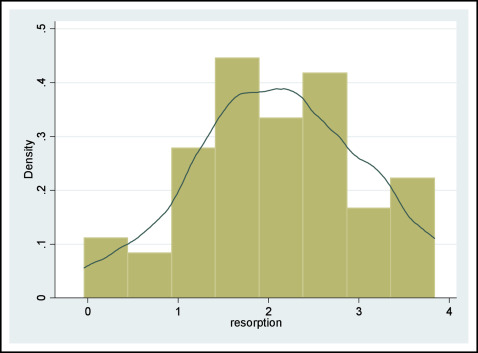When we are making measurements before and after an intervention or at the same time on different sites (split-mouth design) in the same patient, we use a paired t test. The results before and after the intervention or in a split-mouth trial do not comprise 2 independent samples because both samples refer to the same patient. In this case, the 2-sample t test we described in the previous article cannot be used.
Example
Research question: We would like to assess the amount of root resorption from a random sample of patients at the end of orthodontic treatment.
We collected information on 74 patients. For each patient, periapical radiographs were taken before and after the treatment, and we calculated the differences in root resorption. Details on the amount of root resorption are shown in Table I .
| Variable | n | Mean (mm) | SD (mm) |
|---|---|---|---|
| Resorption | 74 | 2.10 | 0.95 |
The histogram in the Figure shows that root resorption follows a distribution close enough to normal.

In Table II , we can see that 74 patients are included in our study. The mean difference in root resorption (difference in root length before and after treatment) and the standard deviation are 2.10 and 0.95 mm, respectively. The associated 95% confidence interval (1.88, 2.31) indicates that the estimated difference in the mean root length reduction after orthodontic treatment can range from 1.88 to 2.31 mm. The P value indicates that the effect of orthodontic therapy on root resorption is statistically significant ( P <0.001), since the probability of finding such a difference by chance is very small.



